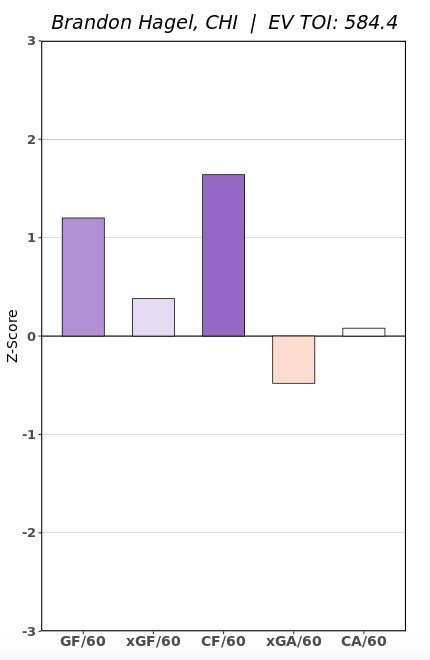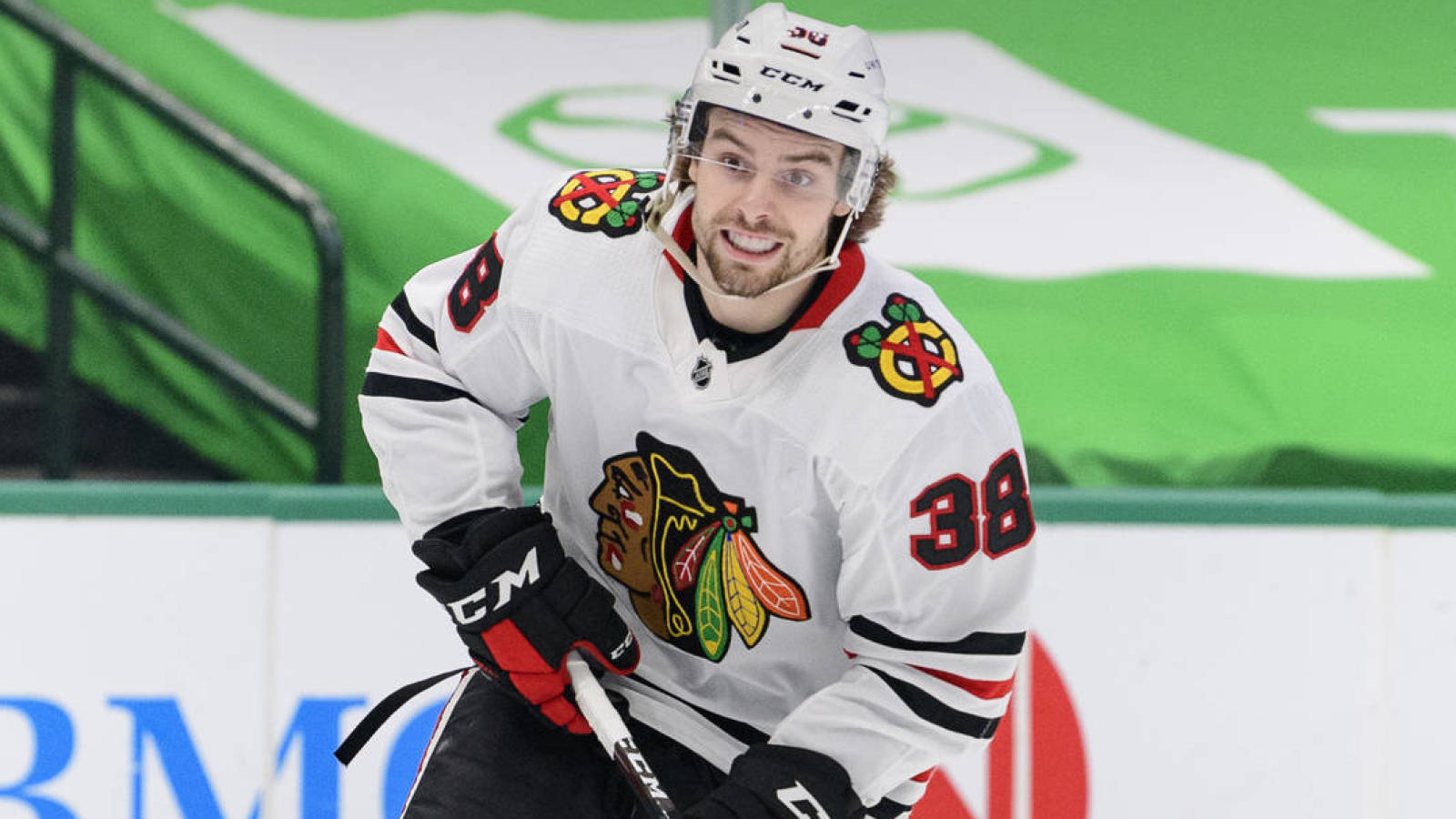In a league with a hard salary cap, finding underpaid players is critical to success.
Allocating a $3.85 million combined cap hit to Michael Bunting, Ondrej Kase, and Jack Campbell has allowed the Leafs to spend in other areas this season. Jason Spezza has also been providing them with great value for several seasons now. With Morgan Rielly set to earn a $2.5 million raise starting next season and Toronto’s goaltending soon becoming more expensive, adding players on bargain contracts will be more important than ever.
Even if the Leafs move out players such as Petr Mrazek and Nick Ritchie, they won’t have much cap space to work with this offseason. Forwards Ondrej Kase and Pierre Engvall are set to become restricted free agents; the same is true for defensemen Rasmus Sandin and Timothy Liljegren. Since the upper limit of the cap is set to increase by only $1 million, Kyle Dubas and co. are going to have to be creative to improve their roster.
Enter Chicago’s Brandon Hagel. The 23-year old winger has established himself as a legitimate top-six winger this season and is signed for bargain $1.5 million cap hit for the next 2.5 seasons. While he wasn’t a known trade candidate at the time, I mentioned him in my “early trade deadline thoughts” article back in early December:
Brandon Hagel, who reminds me a lot of Michael Bunting, is currently playing on Chicago’s top line. He carries a reasonable $1.5 million cap hit through 2023-24 and will be a restricted free agent when his deal expires. While it won’t be easy to pry a 23-year old on a bargain contract out of Chicago, it might be smarter to put a good package together for him rather than a pure rental.
Frank Seravalli of Daily Faceoff placed Brandon Hagel at #4 on his latest NHL Trade Targets Board and mentioned that the Leafs are one of four teams that have engaged in talks with Chicago about Hagel. Seravalli went so far as to state that he’s a good bet to move if the Blackhawks’ high price is met. He believes that the asking price would be in the territory of a first-round pick plus a top prospect.
Getting To Know Brandon Hagel
Hagel, a sixth-round pick in the 2016 NHL Draft, was selected 158 picks after Auston Matthews. He returned to the WHL and scored just over the point-per-game mark for the Red Deer Rebels before breaking out as an overage player with 102 points in 66 games. He then spent the 2019-20 season in the AHL before making the NHL out of training camp last season. He still has fewer than 100 NHL games under his belt, so many NHL fans outside of Chicago probably haven’t even heard of him.
He reminds me a bit of Michael Bunting as a slightly undersized left-winger with a fearless style of play. He’s rarely the fastest or strongest player on his line, but he’s not afraid to get to the dirty areas of the ice and he’s skilled enough to play with his team’s best players. His most common linemates this season are Patrick Kane and Jonathan Toews. He’s also played on both special-teams units.
Hagel has tallied 27 points in 44 games this season, which is a 50-point pace over 82. However, his shooting percentage is north of 19% after he only scored at a 38-point pace last season. Overall, his numbers are fairly comparable to Bunting’s:
| Player | GP | G | A | P | sh% | P/82 GP |
|---|---|---|---|---|---|---|
| Bunting (This Season) | 47 | 16 | 17 | 33 | 15.8% | 58 |
| Hagel (This Season) | 44 | 14 | 13 | 27 | 19.2% | 50 |
| Bunting (Career) | 73 | 27 | 20 | 47 | 18.8% | 53 |
| Hagel (Career) | 97 | 23 | 28 | 51 | 13.7% | 43 |
On a per-minute basis, Bunting only carries a small edge in five-on-five goals this season. Both players have collected just four of their points on the power play, with Bunting carrying a slight edge in primary assists. Hagel is relying on an elevated five-on-five shooting percentage that’s about four percent higher than Bunting’s, but Bunting is playing with better linemates in Matthews and Marner. Bunting also played primarily on Arizona’s top line last season, while Hagel’s main linemates were David Kampf and Dominik Kubalik.
Drawing penalties is a big part of Bunting’s game; he’s one of the NHL’s leaders in minor penalties drawn per minute at five-on-five. While Hagel doesn’t put his team on the power play quite as often, he would rank second on the Leafs in this statistic behind only Bunting. He’s actually slightly smaller than Bunting, but he has dropped the gloves with Patrik Laine and J.T. Compher this season.
Hagel doesn’t shoot as often as Bunting with a five-on-five shots per minute rate that is actually slightly behind Alexander Kerfoot’s. While his own shooting percentage is quite inflated at the moment, he has a linemate with a low shooting percentage in Toews, so his on-ice shooting percentage is 2-3% behind Toronto’s top two left-wingers. Still, I find the lack of shots a bit concerning; I question if he’ll be able to maintain this level of point production in the future.
I see Hagel as more of a complementary player rather than someone who drives his own line. Unlike Ilya Mikheyev or Pierre Engvall, he doesn’t have the height or speed to be a prototypical two-way forward. He’s also rather mediocre in transition. He’s better suited in the bumper role on the power play rather than serving as a primary shooter or playmaker on the perimeter. Here’s a look at how Evolving Hockey’s RAPM views him this season:

Here are a few quotes from Hagel’s head coach, Derek King:
King credited Hagel as the “engine” of his line with Strome and Kane’s success tonight.
“He was everywhere. Everywhere that puck went, he was hunting it down and getting it back to those guys.”
— Ben Pope (@BenPopeCST) January 27, 2022
Derek King on how to avoid “sleepy starts”:
“I guess I just have to start (Hagel) every game and get it going. He’s like a little rabbit out there.”Q: So do that?
A: “I definitely could. Watch Monday, I’ll probably do it, and you’ll be like, ‘I told him that'”— John Dietz (@johndietzdh) January 31, 2022
I believe what we have here is a player with a great “motor” but iffy physical tools. He’s Bunting-like, but he’s not quite Bunting. While he’s a little bit bigger than Nick Robertson, the Leafs already have a young and undersized left-winger with a strong offensive profile.
Like Hagel, Robertson is known for his work ethic and plays on both special teams. Perhaps Hagel is a little bit better around the net than Robertson is, but Robertson certainly has a better shot. Unless Chicago gave me a great offer for Hagel, I’d be inclined to give Robertson a look first before making this trade.
Examining Hagel’s Trade Value
Hagel is 23, or just eight months older than Toronto’s Timothy Liljegren. Chicago certainly does not have to trade him knowing he’s signed to a team-friendly contract for the next 2.5 seasons. He’ll also be a restricted free agent when his current deal expires, so it’s not like acquiring him would be a one-year rental.
He could be a good fit with the Maple Leafs. Sheldon Keefe would certainly clone Bunting if he could, and Hagel could fill a similar role on the team’s second line. He could fill in with Matthews and Marner if Bunting ever got hurt. He also had a fair amount of success with Kampf in Chicago last season. While he’s not big by NHL standards, he could bring a little bit of sandpaper to the table and contribute in all situations.
He’ll cost more than a late first-round pick, and understandably so. Chicago likely believes that if you had a pick in the 20-32 range, you’d probably be happy to get a player like Hagel, so the offer would have to be better than just a first.
While his contract is a bargain, I wouldn’t give up any of Rodion Amirov, Matthew Knies, Nick Robertson, or Topi Niemela in a trade for Hagel, especially if there’s also a first-round pick in the deal. If that’s the price, I’m definitely out. I expect all three of Amirov, Knies, and Robertson to be in the 2023-24 lineup, so if you acquire Hagel, you’re likely expecting him to move into the bottom six at some point.
When the Tampa Bay Lightning acquired Blake Coleman and Barclay Goodrow, a lot of fans focused on the fact that the Bolts were acquiring size and physicality. But there was also the fact that their combined cap hit was just over $2.7 million — less than a third of what they signed for when they hit free agency. The Lightning jammed as much value as they could into their $81.5 million of cap space.
I like Hagel as a trade target given his cap hit; the Leafs could improve their roster while saving money for other positions. However, adding an undersized winger isn’t their #1 need at the moment, and Hagel should not be mistaken for a strong play-driver like Conor Garland.
If I was the Leafs, I’d keep tabs on Hagel, but I don’t think I would pull the trigger on the “a first plus a good prospect” trade, even if the prospect was Roni Hirvonen instead of one of Toronto’s top four. I’d prefer to bring Andreas Johnsson back for a smaller haul while paying a third team to retain 50% of his contract.
If the Leafs trade their first-round pick, I’d rather get a better play-driver than Hagel, who I’d have as a secondary target rather than a primary target — someone to circle back on if they can’t find a better option elsewhere.

































